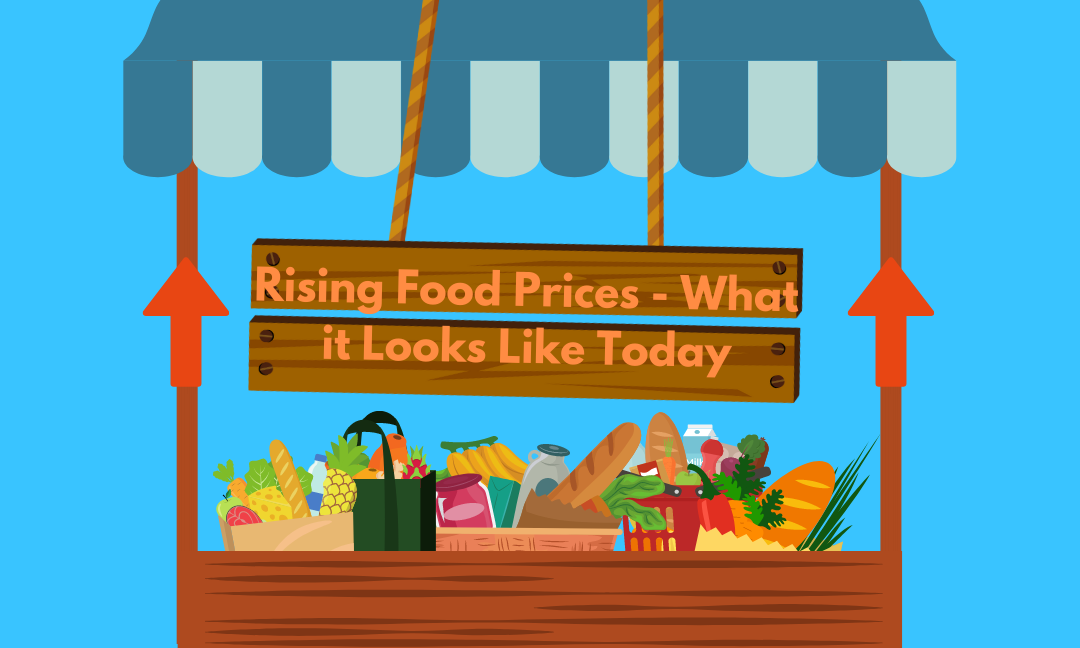Author: Georgia Nicholson
Editor: Emily Cheng
Graphic Designer: Alessia Carpino
Publisher: Rayna Almas
All throughout Canada, the price of living is dramatically increasing. This is very, very, obvious in food prices. The cost of food is said to rise by 5-8% overall in 2022, with specific food groups being hit especially hard. The big picture is that food and living prices will rise higher and higher due to COVID and its aftershocks, a national labour shortage, and the climate emergency. The food price report of 2022 suggests that a family of four will have an annual food expenditure of up to $14,767, an increase of up to $966 from 2021.
The food system in Canada is predominantly domestic trade, so many of the causes of price increase stem from issues from inside of Canada. Visually, it presents like this:
 All of those steps face challenges throughout the year, and this year is no different. There are a few overarching issues that cause difficulty, and will likely continue to make prices rise in the coming years. High inflation, climate change, labour shortages and international conflict all seep into the food industry. A higher cost of feed, energy, fertilizer, and weather instability due to climate change all affect the production of food. In the processing portion, food processors struggle with increasing labour cost and labour shortages. All around Canada, there has been an average job vacancy of 5.45, but in food manufacturing, it is 6. While that doesn’t seem too different, that 0.6% is actually substantial. If you were wondering, distribution is where the trucker convoy fits in. Surprisingly, the vaccine mandate imposed on truckers that sparked the protests in Ottawa does not affect the transportation of food as much as it would seem; it more so affects the transportation of material goods from the U.S.
All of those steps face challenges throughout the year, and this year is no different. There are a few overarching issues that cause difficulty, and will likely continue to make prices rise in the coming years. High inflation, climate change, labour shortages and international conflict all seep into the food industry. A higher cost of feed, energy, fertilizer, and weather instability due to climate change all affect the production of food. In the processing portion, food processors struggle with increasing labour cost and labour shortages. All around Canada, there has been an average job vacancy of 5.45, but in food manufacturing, it is 6. While that doesn’t seem too different, that 0.6% is actually substantial. If you were wondering, distribution is where the trucker convoy fits in. Surprisingly, the vaccine mandate imposed on truckers that sparked the protests in Ottawa does not affect the transportation of food as much as it would seem; it more so affects the transportation of material goods from the U.S.
The previous causes affect different food groups in varying intensities. The prices of wheat products – , specifically bakery goods, are set to increase by 5-7% because Western Canada had an extremely hot and dry summer. For 60 days, virtually no rain fell in all of the prairies. This event can be attributed to climate change, and we will likely see more summers like these in the future. Another large sector set to increase is the restaurant industry, which obviously can be attributed to COVID closures and national labour shortage. Even the milk marketing board is getting affected. Usually, because milk is a controlled industry, (see this link for more explanation), prices are regulated the same for all manufacturers, and the price remains constant. However, the Dairy Farmers of Ontario have just ruled to increase the price of milk by 8.4% to account for increases in production cost. Interestingly, meat and seafood prices are not expected to go up at all, if a little, if not at all.
So, what does that mean for Canadians? Well, unfortunately this issue falls right alongside all the other costs that are rising this year, like gas, real estate, retail items – you name it. Additionally, salaries and wages have not updated to reflect those increases, and the dream of livable wages fades into the horizon. Another way the labour shortage affects Canadians, specifically young people, is that we are entering a workforce with a deficit of workers, often specifically in healthcare and teachers. Food, I will remind you, plays a huge part in one’s annual spending. According to the 2019 Global Food Security Index, Canada ranked 18th in the world in 2019 when for food affordability was measured. Now, in 2021, Canada ranks 24th in the world. This, at its simplest, means that Canadians will have less money in their bank accounts, as more of it will go towards surviving.
And now we have reached that point in the article where I tell you that there is still hope, as long as you do the following things. There is the option to adopt lifestyle practices like shopping local, supporting increased production of local food, or buying sustainable food. And you can also support specific political movements, such as the raising of the minimum wage to account for a rising cost of living, supporting the mitigation of climate change, or even supporting the automation in food production. All of the issues Canada faces intertwine, especially in this issue, so getting to the causes of rising food prices and preventing them is the most sustainable course of action.
Works cited:
https://www.cbc.ca/news/business/food-price-report-charlebois-1.6277590
https://www.ctvnews.ca/business/here-s-a-look-at-what-s-going-to-cost-more-in-2022-1.5722156

